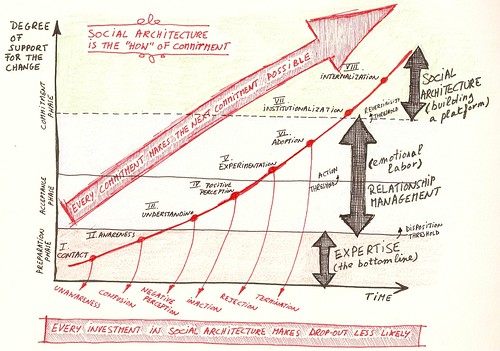In the early ’80s Daryl Conner published a model that explains the 8 stages of commitment. The model describes how and when people become committed to major new organizational requirements. The model works extremely well as pattern recognition and sense-making for large scale organizational change programs.

The vertical axis represents the degree of support for the new mindsets and behaviors, and the horizontal axis reflects the passage of time. The model consists of three developmental phases—Preparation, Acceptance, and Commitment—and the stages unique to each phase.
Each stage represents a juncture critical to the development of commitment to change. A positive perception of change may stall (depicted by downward arrows) or increase (represented by an advance to the next stage). In addition, as people learn more about the change and what it will require, they may return to earlier stages in the process. The successful transition through a particular stage serves as the basis for experiencing the next stage.
In an earlier post I have explored the logic of commitment and found that every commitment – how small and insignificant it may seem – makes the next commitment possible. This makes perfect sense and tells us a great deal about how we need to organize in order to reach the highest level of commitment. In short, it tells us that we should start early with the engagement of the target population and that we should take small steps.
Another thing that is useful to note is that involving people from the very beginning has some positive (and sometimes unexpected) side-effects: people tend to connect among themselves and build a community around the expertise or subject of the change at hand.
This brings me to one of my favorite topics: Social Architecture. People need an architecture that helps them to connect and share their knowledge and this is a three step process as shown in the drawing below.

- You need expertise in order to get the job done. This gets your foot inside the door;
- Next, you need to consistently prove that you are worthy of people’s trust;
- Finally, when people allow you a landing slot on their airport of trust, you are ready to build a platform.
In the end, what does this mean for you as an organizational change practitioner? Consider the following entry criteria in order to enter the next level:
- Be an expert, that is the bottom line;
- Then, let go of the attachment to being an expert and do the emotional labor that builds trust;
- Finally, in order to build a platform, you will need to get out of the way and allow the community to take over.
To me the link with the 8 stages of commitment of Daryl Conner is obvious (and I can’t understand why I did not see it before). The way we create a social architecture is the way we ascend the 8 stages of commitment. Now have a look at what happens when we map the social architecture steps on the chart of the 8 stages. What does it tell us about the thresholds? And what else can we learn from it?
- A first conclusion is that expertise alone will not get us very far. Being knowledgeable (or *certified*) in the area of organizational change management will give you the skills to create awareness (at best). Anything beyond that will require you to invest emotional labor (in terms of Conner’s model: ‘passing the disposition threshold’)
- A second conclusion is that the second level of social architecture can get you quite far on the ladder of commitment. With emotional labor you can engage people. This is why this second level of social architecture gets you easily past the action threshold . no doubt about that.
- However – and this is a third conclusion – that last threshold of reversibility can only be achieved when you have allowed people not only to participate (relationship management) but also to connect with one-another is a way that they can leverage upon when you are no longer there to support them.
In conclusion: If we organize these commitments carefully we are not only building commitment but also strengthening the fabric of community. It’s that simple. So let’s stop whining about that 70% focus on the opportunities we almost stumble over every day.




Pingback: Mapping Projects Against Commitment | Reply-MC()